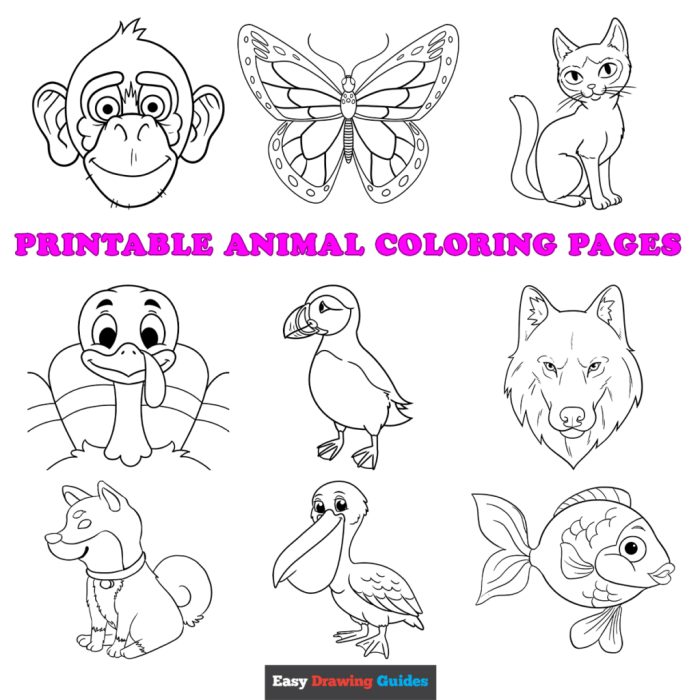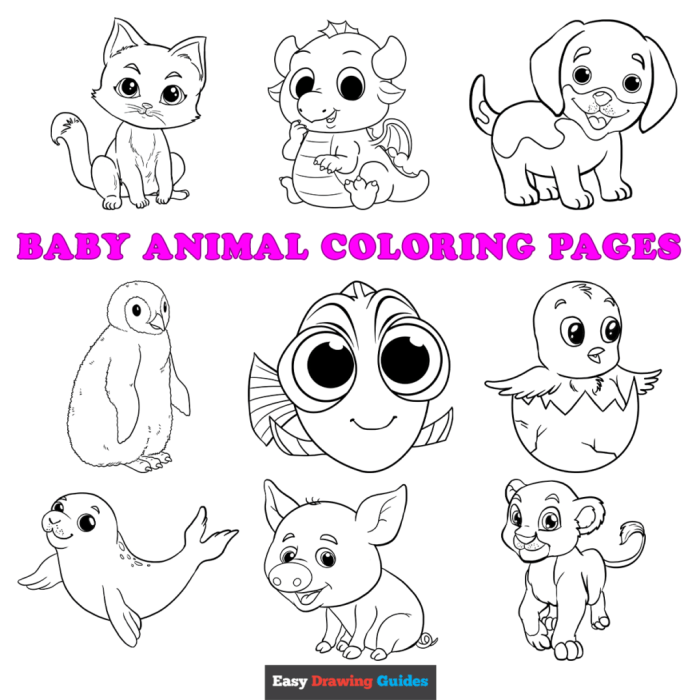Popularity and Trends: Animal Coloring Pages Black And White

Animal coloring pages black and white – The online popularity of black and white animal coloring pages remains substantial, driven by a consistent demand for stress-reducing activities and creative outlets. This market segment shows resilience, adapting to evolving digital trends and maintaining a strong presence across various platforms. While precise quantitative data on downloads or website traffic is difficult to obtain comprehensively, anecdotal evidence and search engine trends suggest a consistently high level of engagement.
Top Five Popular Animals and Design Trends
The popularity of specific animals in coloring pages fluctuates somewhat, influenced by cultural trends and current events. However, certain animals consistently rank highly. Analysis of numerous online coloring page resources and social media posts suggests a clear preference for certain subjects. This preference is influenced by factors ranging from inherent cuteness (e.g., puppies) to cultural significance (e.g., pandas).
The design style, too, shows a clear evolution.
| Animal | Popularity Rank | Design Style | Year Trend Started |
|---|---|---|---|
| Dogs (various breeds) | 1 | Mix of simple and intricate; increasing complexity over time | 2010s (early) |
| Cats (various breeds) | 2 | Similar to dogs; a range of styles from simple to highly detailed | 2010s (early) |
| Birds (owls, parrots, etc.) | 3 | Often intricate, focusing on feathers and details; simpler designs also common | 2010s (mid) |
| Pandas | 4 | Mix of styles; from simple Artikels to more detailed representations | 2010s (mid) |
| Horses | 5 | Often more intricate, emphasizing musculature and details; simple designs also exist | 2010s (early) |
Design Style Evolution Over Five Years
Over the past five years, a noticeable shift in design trends has occurred within the black and white animal coloring page market. While simple, Artikel-based designs remain popular, particularly for younger children, a clear trend towards more intricate and detailed designs is evident. This trend is likely driven by the increasing popularity of adult coloring books, which often feature highly complex patterns and designs.
For example, five years ago, a simple Artikel of a dog might have been typical; today, coloring pages featuring dogs often incorporate detailed fur textures, intricate backgrounds, and complex patterns within the animal’s form. This evolution reflects a broader trend toward more sophisticated and challenging coloring activities.
Target Audience Analysis

The success of animal coloring pages hinges on understanding the diverse needs and preferences of the target audience. This analysis examines the age ranges most likely to engage with black and white animal coloring pages, exploring the specific interests and therapeutic benefits for each group. Understanding these nuances is crucial for effective marketing and product development.The primary target audience for black and white animal coloring pages spans a wide age range, encompassing preschoolers, elementary school children, and even adults.
Each group, however, exhibits unique characteristics influencing their engagement with this activity.
The simplicity of animal coloring pages black and white allows for creative freedom, fostering imagination through basic linework. A contrasting approach is found in the more intricate detail of alice in wonderland coloring pages anime , showcasing a different style of artistic expression. Returning to the monochromatic simplicity, animal coloring pages offer a calming, accessible activity for all ages, regardless of artistic skill.
Age Group Segmentation and Interests
The appeal of animal coloring pages varies significantly across age groups. Preschoolers (ages 3-5) are drawn to simple, large designs featuring familiar animals like cats, dogs, and farm animals. Their focus is on the process of coloring itself, developing fine motor skills and hand-eye coordination. Older children (ages 6-12) tend to prefer more complex designs with intricate details, potentially including exotic animals or mythical creatures.
Their interest shifts towards creative expression and the ability to personalize their creations. Adults, meanwhile, often utilize coloring as a form of stress relief and mindfulness, appreciating detailed mandalas or realistic animal portraits. Their focus is on the therapeutic benefits and the opportunity for creative self-expression.
Therapeutic Benefits of Coloring Across Age Groups, Animal coloring pages black and white
Coloring offers a range of therapeutic benefits across the target age groups. For preschoolers, it aids in developing fine motor skills, hand-eye coordination, and color recognition. For elementary school children, coloring can improve focus and concentration, providing a calming activity that counteracts the demands of school. For adults, coloring acts as a powerful stress reliever, promoting relaxation and mindfulness through focused attention.
The repetitive nature of the activity can be meditative, reducing anxiety and improving mental well-being. Studies have shown that engaging in creative activities like coloring can lower cortisol levels (the stress hormone) and increase feelings of well-being. This is particularly relevant in today’s fast-paced, high-stress society, where adults increasingly seek accessible methods for stress management.
Target Age Group Characteristics
The following bullet points summarize the key characteristics of each target age group:
- Preschoolers (3-5 years): Simple designs, large Artikels, familiar animals (cats, dogs, farm animals), focus on motor skill development and color recognition. Low skill level, requiring minimal detail.
- Elementary School Children (6-12 years): More complex designs, intricate details, broader range of animals (including exotic and mythical creatures), increased focus on creative expression and personalization. Moderate to high skill level, capable of handling more detail.
- Adults (18+ years): Highly detailed designs, realistic animal portraits or mandalas, focus on stress relief, mindfulness, and creative self-expression. High skill level, potentially seeking challenging designs.
Design and Artistic Aspects
The visual appeal of black and white animal coloring pages is paramount to their success. A diverse range of artistic styles, coupled with thoughtful consideration of line weight, shading, and detail, significantly impacts the overall user experience and the final colored product. Careful design choices cater to various age groups and skill levels, ensuring broad appeal.
Black and white animal coloring pages employ a variety of artistic styles to engage different audiences. These styles range from photorealistic representations capturing intricate details to simplified, cartoonish designs ideal for younger children. Minimalist approaches, focusing on essential shapes and lines, offer a different aesthetic altogether, allowing for creative interpretation.
Artistic Styles and Technical Aspects
Line weight plays a crucial role in defining the animal’s form and features. Thicker lines provide a bolder, more defined look, often found in cartoonish styles, while thinner lines create a more delicate and detailed effect, common in realistic illustrations. Shading techniques, ranging from simple hatching and cross-hatching to more complex stippling and blending, add depth and dimension to the animal’s features.
The level of detail varies widely, from highly detailed renderings with numerous small elements to simpler designs with only basic Artikels. Consider, for instance, the difference between a meticulously detailed lion’s mane versus a simplified, almost symbolic representation of the same animal.
Coloring Page Design Concepts
Three distinct coloring page designs featuring a single animal – a majestic elephant – are proposed below, each illustrating a different artistic style:
Design 1: Realistic Style: This design features a detailed rendering of an African elephant, capturing the texture of its skin, the wrinkles around its eyes, and the individual strands of grass in its environment. The line weight varies subtly, creating a sense of depth and form. Cross-hatching and stippling are used to create shading, emphasizing the elephant’s musculature and the shadows cast by its body.
The level of detail is high, with many small elements included to enhance realism.
Design 2: Cartoonish Style: This design features a simplified, friendly elephant with exaggerated features. The lines are bold and black, with a consistent, thick line weight throughout. Shading is minimal, using simple black areas to suggest depth. The level of detail is low, focusing on the animal’s essential features and creating a playful aesthetic.
Design 3: Minimalist Style: This design features a highly simplified representation of an elephant, using only basic geometric shapes and lines to convey its form. The line weight is consistent and thin, creating a clean and uncluttered look. Shading is absent, allowing for maximum creative freedom during coloring. The level of detail is extremely low, focusing on the essence of the animal’s form.
Comparative Table of Coloring Page Designs
| Style | Line Weight | Shading | Detail Level |
|---|---|---|---|
| Realistic | Variable, subtle | Cross-hatching, stippling | High |
| Cartoonish | Consistent, thick | Minimal, simple black areas | Low |
| Minimalist | Consistent, thin | Absent | Extremely Low |
Content Creation and Distribution

Creating and distributing high-quality black and white animal coloring pages requires a strategic approach encompassing both artistic skill and effective marketing. Success hinges on generating appealing designs and leveraging appropriate platforms to reach the target audience. This section details methods for content creation and Artikels various distribution channels, analyzing their respective advantages and disadvantages.High-quality black and white animal coloring pages can be created using a variety of methods, each offering unique advantages.
Digital software provides precision and scalability, while traditional methods offer a more tactile and artistic experience. The choice depends on the creator’s skillset and desired aesthetic.
Digital Content Creation Methods
Digital software offers precise control and efficient scaling for mass production. Popular options include Adobe Illustrator, which is ideal for vector-based illustrations allowing for easy resizing without loss of quality, and Krita, a free and open-source raster graphics editor offering a wide range of brushes and tools suitable for both detailed and simple designs. Creating a coloring page in Illustrator involves sketching the animal, outlining it with vector tools, and then filling in areas with black to create the coloring space.
This vector-based approach allows for easy modification and printing at various sizes. In contrast, Krita’s raster-based approach provides a more painterly feel and is well-suited for creators who prefer a hand-drawn look.
Creating a Simple Black and White Animal Coloring Page Using Adobe Illustrator
A simple black and white animal coloring page can be created in Adobe Illustrator using the following steps:
1. Sketch
Begin by sketching the desired animal using the pencil tool. This initial sketch doesn’t need to be perfect, serving as a guide for the final artwork. For example, a simple Artikel of a cat could be drawn, focusing on the basic body shape, head, tail, and ears.
2. Artikel
Use the pen tool to create precise Artikels over the sketch. This step creates clean, vector-based lines for the coloring page. Each section of the cat—body, head, tail, legs—would be Artikeld separately to ensure distinct coloring areas.
3. Fill
Select the areas within the Artikels and fill them with black. This creates the solid black areas that will be colored in by users. Any internal details, like eyes or whiskers, should also be filled in black.
4. Clean Up
Remove the initial sketch layer. Review the lines and make any necessary adjustments to ensure clean, smooth Artikels.
5. Export
Export the artwork as a high-resolution PDF or PNG file suitable for printing or online distribution.
Distribution Channels
Choosing the right distribution channels is crucial for maximizing reach and generating revenue. Different platforms cater to various audiences and offer unique advantages and disadvantages.
- Websites: Creating a dedicated website allows for direct sales and branding control. However, it requires web development skills and ongoing maintenance.
- Social Media: Platforms like Pinterest, Instagram, and Facebook offer extensive reach but may require paid advertising for optimal visibility. Organic reach can be limited.
- Print-on-Demand Services: Services like Printful or Redbubble handle printing and shipping, eliminating the need for inventory management. However, profit margins may be lower due to service fees.
- Etsy: Etsy provides a marketplace for selling digital and physical products, offering a built-in customer base. However, competition can be fierce, requiring effective marketing strategies.
